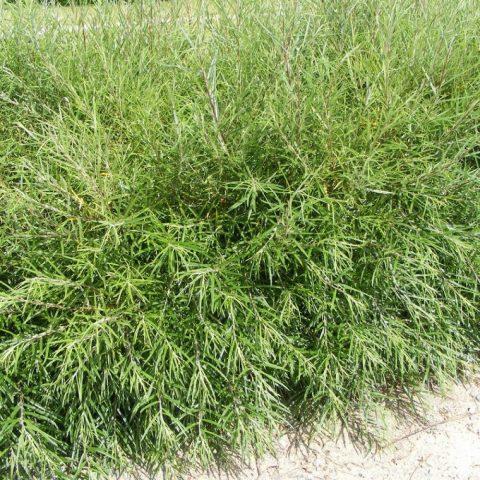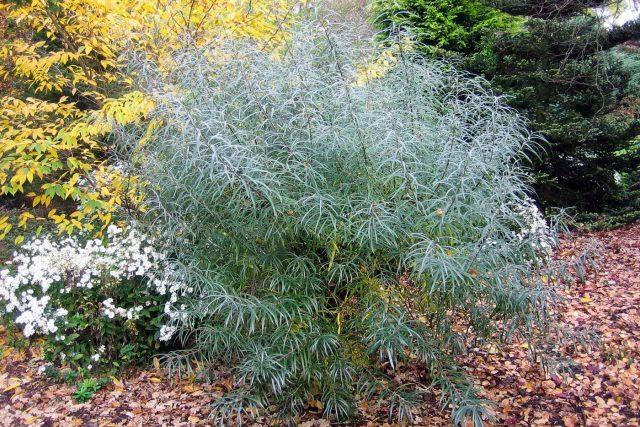Content
Rosemary willow is a unique species that is a low shrub. This is precisely why designers respect it, using it to improve private and public areas. The plant is unpretentious and can grow in almost any soil.
Description of rosemary willow with photo

Photo of young rosemary willow
Under natural conditions, the culture grows in Europe and Asia, preferring a warm climate. Willow can take root in swampy and sandy areas, in dense forest. The shrub is notable for its spreading crown, which is most beautiful in young specimens. Thanks to this, the variety has found application in landscape design. In addition to it, two more willows are used in the design - climbing and spherical.
The leaves have an oval shape, the veins are clearly visible. They reach about 2.5 cm in length and 0.5-1 cm in width. The stipules fall off over time. Before maturity, the plant looks fluffy due to the matte structure of the green mass. Over the years it becomes glossy. By autumn, the leaves begin to turn yellow, then turn orange and fall off.
Willow blooms in mid to late spring. The bush produces many elongated earrings, which gradually envelop the trunk. With the arrival of the sun, the willow crown begins to bloom. The leaves have a characteristic green-bluish tint. By the beginning of summer, the fruits become ripe and lose moisture.

Rosemary willow seeds germinate faster in moist soil
The plant has a good structure. Willow branches are quite soft, but are not afraid of strong winds. Since the foliage is small, the crown retains its decorative shape for a long time. If you do not prune, the trunk and branches of the willow will become stronger. The powerful root system allows it to grow in moist soil. For this reason, willow grows near rivers and swamps. The roots strengthen the soil and prevent the formation of ravines, which can be useful for domestic purposes.
The leaf of willow rosemaryfolia resembles rosemary, which is why the plant got its name. In summer the leaves are green or blue, and in winter they are dark purple. Despite its love for warmth, willow copes well with frost. In this regard, the bushes can be safely planted in Russia.
Rosemary willow is rarely found in natural conditions. It is bought in the form of seedlings and used to improve the area. The variety is listed in the Red Book, so it must be handled with care.
Height of rosemary willow
Because rosemary willow is a shrub, it does not grow to a large size. Even in optimal conditions, the height of the plant rarely exceeds 2.6 m. At the same time, the willow crown can stretch up to 3.6 m. In wild conditions, growth rates are lower - on average up to 2.2 m with a crown width of 3.1 m.
Advantages and disadvantages
Willow is remarkable for its appearance. A lush crown can become a source of pride for any gardener.

A hedge made of rosemary willow will diversify the design of the site
Pros:
It can grow in different soils - forest, meadow, sandy, swamp.
Amenable to pruning - the soft branches of rosemary willow allow you to form a crown of the desired size without much effort.
Willow is not afraid of cold weather. The variety grows calmly in arid and cold (up to – 30 °C) climates.
Willow has a persistent root system - this allows the plant to be used to prevent the formation of ravines.
Minuses:
If you don't prune, the branches become stiff and more difficult to remove.
Using rosemary willow as a hedge, you may encounter an abundance of birds, which will reduce the number of neighboring berries.
Hedging moistens the soil, but this may be beneficial for certain soil types.
When planting, it is worth considering that the bark of the plant can be eaten by beavers. If the site is not fenced, there may be nothing left of the crop.
Planting rosemary willow
In order to place the variety, you need to take into account the nature of the soil. It is best to use moist substrates. Coastal strips, peat and even clay are suitable for cultivation. The main thing is that the soil is medium or slightly acidic.

Sometimes rosemary willow is found in European forests
In the shade, willow grows more slowly and its branches become thinner. Gardeners do not recommend planting the bush in areas accessible to the wind. Rosemary willow is kept away from foreign objects at a distance of up to two meters. Planting is done in mid-spring, the optimal air temperature is 7-13 °C. The soil is prepared in advance - dug up in the fall. The plant is deepened into a hole 65x65 cm.
Caring for rosemary willow
After planting, the variety requires special care. The owner will need:
Water once a week. In the warm season - up to three times.
Periodically loosen the soil (preferably immediately after watering).
Cover during extreme cold (if the thermometer shows below – 30°C).
Feed rosemary willow in autumn and mid-May.
It is also necessary to mulch the soil in late autumn with bark and peat (a layer of 10 cm).
Reproduction methods
The bush is propagated using seeds, seedlings or cuttings. In the latter case, you need to follow the following algorithm:
Cut off a young branch on which the leaves have not yet opened
Place in water, organize fertilizing (growth stimulator).
If there is no fertilizing, use nutrient-rich soil and moisten it regularly.
Place rosemary willow in a bright area, excluding direct sunlight.
After it takes root, it can be replanted to a permanent location.

This is what a rosemary willow seedling looks like
Rosemary willow can be transplanted into a container with prepared soil. She winters in rooms with low temperatures. With the arrival of heat, they are moved to the main area.
Diseases and pests
The following insects are dangerous to the health of the variety:
barbel;
aphid;
mite;
caterpillar.
After their attack, it is necessary to remove the damaged areas and treat rosemary willow with an insecticide.
The species is practically not susceptible to diseases, but is susceptible to fungi. The appearance of red and dark spots may be a sign of rust. They can form on both foliage and branches. After this, the shoots will begin to fade.They must be burned and the bushes treated with a protective solution.
Rosemary willow in landscape design
Designers noticed willow back in the 19th century. They used it to maintain the coastline of artificial reservoirs. English aristocrats often decorated their estates with the plant. Willow and its shrub varieties can be used today, but as a hedge. It is enough to plant several seedlings (up to 1 m from each other) and after a few years a beautiful living wall will form.

A beautiful combination of different plants, including rosemary leaf variety
Willow is also used in a single format, for example, in a mountain landscape. The view looks good against the backdrop of stones and flowers. Designers advise growing the crop next to birch, lilac and spruce trees.
Conclusion
Rosemary willow is an amazing variety that can be used for a variety of purposes. The shrub requires almost no care and grows in any soil. After planting, the plant will delight the owner for a long time with its luxurious crown. Gardeners note that rosemary willow does not require watering if placed in moist soil.
Reviews of rosemary willow








